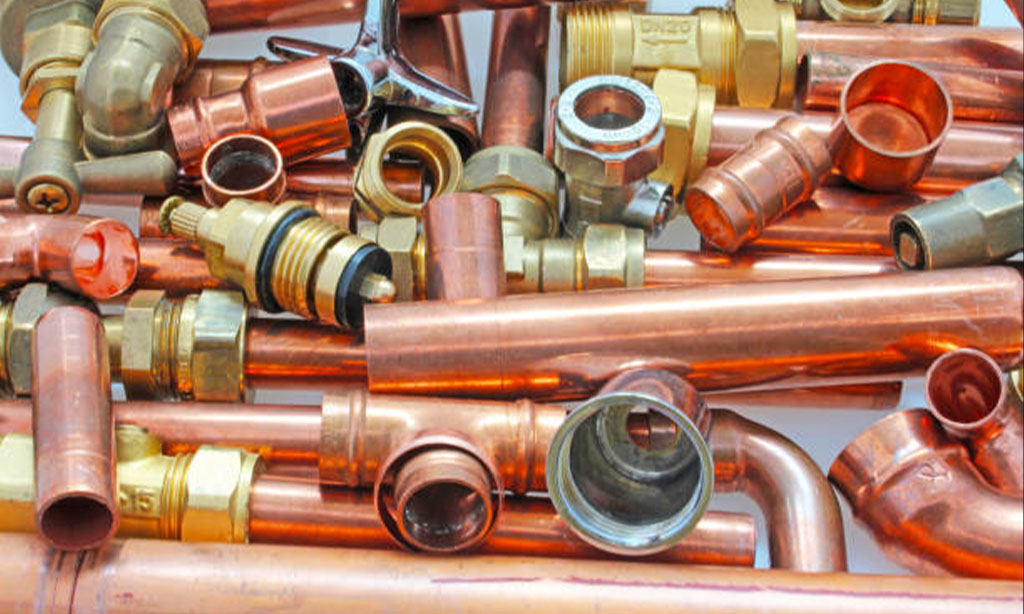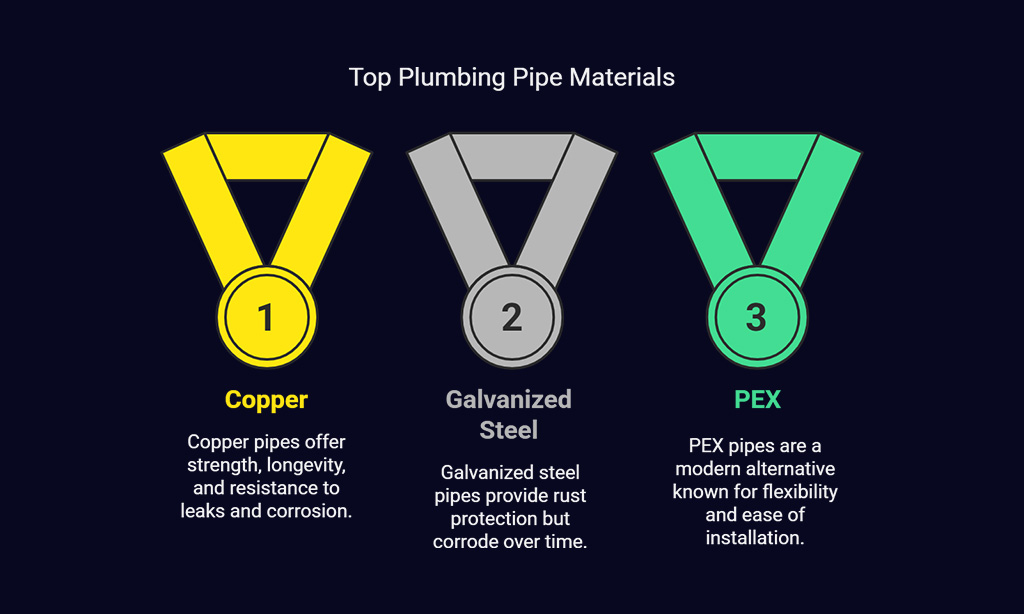Plumbing problems can cause a lot of headaches. Leaks, rust, or even outdated pipes might be costing you more money than you think. Choosing the wrong pipe material could lead to water damage or higher utility bills.
In 2025, new plumbing materials are helping homeowners save water and reduce energy use. For example, PEX pipes resist corrosion and last longer than many old-style options. They’re also easier to install for DIY projects.
This guide will help you pick the best pipe materials for your needs. We’ll cover durable choices like copper and newer eco-friendly options too. Keep reading—you don’t want to miss this!
Key Factors to Consider When Choosing Pipe Materials
Choosing the right pipe material can save money and prevent future headaches. Think about how it will handle wear, costs, and impact on the planet.
Durability and Longevity
Copper pipes are praised for their strength. They can last about 80 years with proper care, making them a trusted choice. These pipes resist leaks better than many materials. PVC and PEX pipes outperform copper in longevity, lasting over 100 years without corrosion.
Composite pipes shine as modern options. They combine durability with resistance to chemicals and scale build-up. PEX also resists water-related damage, staying strong under pressure.
Strong materials mean fewer plumbing repairs down the road.
Long-lasting pipes save money and hassle.Cost-Effectiveness
PEX pipes save money. They are cheaper than copper pipes. Homeowners like them because they are easy to install. This means fewer hours spent on labor costs.
PVC and ABS pipes also help reduce expenses. These materials last over 100 years, offering long-term value for plumbing systems. Copper pipes, while strong, cost more upfront but may need replacement after about 80 years.
Choosing the right pipe can lower utility bills by reducing leaks and wasted water over time.
Environmental Sustainability
Eco-friendly plumbing focuses on reducing water waste and energy consumption. PEX pipes last over 100 years, resisting chemicals and corrosion. Composite pipes, made from sustainable materials, replace older options like copper in many plumbing upgrades.
Low-flow fixtures like toilets and faucets help conserve water daily.
Recycled pipe materials are gaining popularity in the plumbing industry for 2025. They combine durability with reduced environmental impact. Smart-home tools like leak detection systems prevent wasted water, saving money on utility bills while protecting clean drinking water supplies.
Plastic Pipe Options
Plastic pipes are affordable and easy to install. They work well for homes, carrying both hot and clean water safely.
Polyvinyl Chloride (PVC)
PVC pipes are lightweight and easy to install. They resist corrosion, chemicals, and rust from water. This makes them a popular choice for plumbing upgrades in homes. These plastic pipes can last more than 100 years if maintained well.
They work great for clean water supply lines and waste-management systems. PVC is cost-effective compared to copper or galvanized steel options. It handles hot water but isn’t ideal for extreme heat situations like tankless heaters or heating systems above 140°F.
Cross-Linked Polyethylene (PEX)
PEX pipes are flexible and easy to install. Homeowners enjoy using them for plumbing upgrades. These pipes resist corrosion, chemicals, and scale build-up. They can handle both hot and cold water systems well.
Unlike copper pipes, PEX doesn’t rust or leak easily over time. It lasts over 100 years with proper maintenance and repairs. Many homes now use PEX piping because it’s cost-effective and durable.
It has become a favorite in the plumbing industry for reducing energy consumption through efficient water flow.
Acrylonitrile Butadiene Styrene (ABS)
ABS pipes are lightweight and tough. They work well for drain, waste, and vent systems. Their black color makes them easy to spot in plumbing setups. ABS handles cold weather better than many other plastics.
It resists impact and cracking too.
These pipes are budget-friendly for home upgrades. Installation is simple due to their low weight. They don’t corrode or rot like some metal pipes might over time. Because of these traits, many DIY homeowners pick ABS for quick fixes or new projects in 2025 trends.
Metal Pipe Options
Metal pipes bring strength and reliability to plumbing, offering solid choices for various needs—find out which fits your project best!
Copper
Copper pipes are known for their strength and long life. They last around 80 years, making them a solid choice for plumbing upgrades. These pipes also resist leaks better than many other materials like galvanized steel or cast iron.
Many licensed plumbers still call copper the “gold standard” of the plumbing industry.
These pipes handle high water pressure without breaking down easily. They also don’t rust, which helps keep drinking water safe from dirt or contamination. While newer trends like PEX and composite pipes draw attention, copper remains a trusted option for safer water supply lines in homes and businesses alike.
Galvanized Steel
Galvanized steel pipes are coated with zinc to prevent rust. They were common in old homes but are being replaced by better materials like PEX and PVC. These pipes can last up to 50 years, but they corrode over time.
Corrosion leads to leaks and reduced water quality.
They work well for outdoor plumbing, like garden faucets or irrigation lines. Yet, using them for drinking water isn’t a great idea today. The inside coating may wear off, releasing harmful particles into your supply.
Modern homeowners often choose eco-friendly options instead of galvanized steel due to its limitations in longevity and safety concerns.
Cast Iron
Cast iron pipes are heavy and strong. They can last over 100 years with good care. These pipes are great for noise reduction. Water flows through them quietly, unlike many other pipe types.
Cast iron resists heat well, which makes it safe for heating systems.
They do have downsides. Cast iron is prone to rust over time, especially in humid areas. It is also harder to install due to its weight, needing skilled hands like a licensed plumber’s help.
Many older homes still use these pipes today, but newer materials often replace them during plumbing upgrades for better energy efficiency and water conservation solutions.
Emerging Trends in Plumbing Materials for 2025
Plumbing is getting smarter and greener. New materials aim to save water, cut costs, and last longer.
Pipes Made from Recycled Materials
Recycled materials are becoming game-changers in plumbing upgrades. Some pipes now use scrap metal or plastic from old products. These eco-friendly plumbing options lower waste and conserve resources.
They also help reduce energy used in producing new materials.
New bio-materials are strong enough for water pressure, matching traditional options like PEX pipes. Such sustainable materials align with modern goals of cutting down utility bills and boosting energy efficiency.
Using these green choices supports environmental protection efforts without sacrificing quality.
Composite Pipes for Enhanced Performance
Composite pipes combine plastic and metal layers. They can replace traditional copper piping in 2025. These pipes resist corrosion, chemicals, and scale build-up. Their design makes them strong yet flexible for easy installation in plumbing upgrades.
Homeowners like these pipes for their durability and long life. Composite materials also help cut utility bills by preventing leaks better than older options like galvanized steel or cast iron.
DIY enthusiasts appreciate how simple they are to handle with basic pipe fittings while reducing the chances of errors during setup.
Takeaways
Choosing the right pipes makes a big difference for plumbing. PEX and PVC are long-lasting, easy to install, and resist harsh conditions. Copper remains strong and reliable but may cost more.
New trends like recycled or composite materials offer greener options. Pick the best fit for your needs and enjoy better water systems in 2025!
FAQs
1. What are the best pipe materials for plumbing in 2025?
PEX pipes and copper pipes are top choices. PEX is flexible, durable, and great for water conservation. Copper lasts long but costs more.
2. Are there eco-friendly plumbing options available?
Yes, sustainable materials like PEX and gray water recycling systems support eco-friendly plumbing trends.
3. How can modern pipes help with leak prevention?
Newer materials like self-healing polymers reduce leaks by sealing small cracks on their own.
4. Do smart home technologies affect plumbing upgrades?
Absolutely! Smart faucets, motion sensors, and touchless fixtures improve energy efficiency while saving water.
5. Should I replace old lead pipes in my home?
Yes! Lead pipes pose serious health risks like lead poisoning. A licensed plumber can install safer alternatives like copper or PEX.
6. Can better pipe materials lower utility bills?
Yes, using energy-efficient systems such as tankless water heaters paired with proper piping reduces heating water costs over time.







































